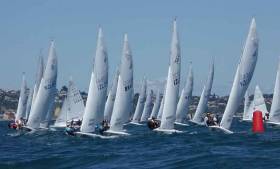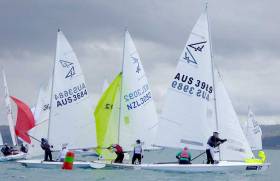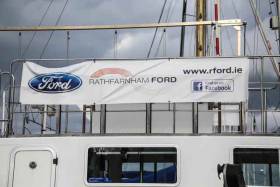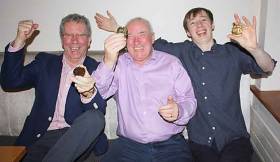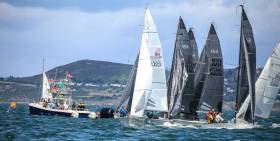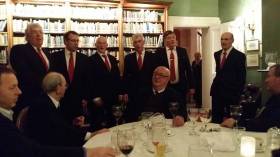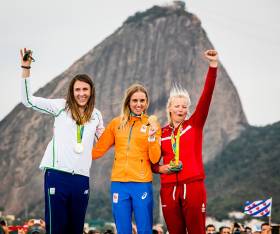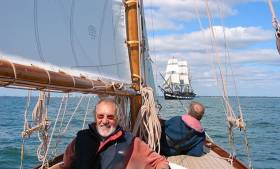Displaying items by tag: National Yacht Club
Does ICRA Mean 'Ireland's Craziest Racers Afloat'?
On the other hand, ICRA could equally mean 'Ireland’s Cool Runnings Assembly'. In the week in which the Travelling Community was granted Ethnic Minority Status, W M Nixon finds himself among two groups which might be equally deserving of such recognition.
You know how it is as we swing into Spring and its embarrassment of Saturday choices. There it was, Saturday 4th March coming up on the busy agenda, and the inevitable dilemma. Should we be in Cowes for the Annual General Meeting of the Association of Yachting Historians in the Squadron castle? Or was appearance mandatory at the Irish Cruiser Racing Association’s day-long Annual Conference in Limerick, followed by a mysterious awards ceremony that night in the Royal Irish Yacht Club in Dun Laoghaire?
The old Learjet being no longer airworthy, it was a case of staying on the Irish island rather than that of Wight, and trusting that our car-of-a-certain-age-of-a-Swedish-brand-which-is–no-longer-manufactured would be up to the rigours of the M7. For the fact that trains go only to railway stations rather than your actual destination made the car the only option for a trans-island logistical challenge in very limited time.
 The ICRA Annual Conference has become a staple of the early Spring programme
The ICRA Annual Conference has become a staple of the early Spring programme
I know some people do double journeys like this five days a week as part of their working lives, and take it for granted. However, as one who rates long-distance commuting right up there with wind farms as one of the crazier things about modern life, it’s quite an effort to get the body there and back again, and the soul takes even longer.
What on earth can it all be for? But then you step into the Conference Centre in the Castletroy Park Hotel with everyone – most of them acquaintances and many old friends - sat in companionable comfort around a mega-table as though we’re negotiating peace in Syria. And it’s like stepping into a judiciously-drawn bath of the perfect temperature. For these are kindred spirits, upwards of seventy of them from all parts of Ireland, and we’re going to talk about boats and sailing matters all day. Bliss.
For an outsider, though, I can see that this must seem like a separate species talking in their own language. The thought of Travellers rattling away in Shelta at the Ballinasloe Horse Fair springs to mind. So yes indeed, let’s give ICRA enthusiasts Ethnic Minority Status. After all, like Travellers, ICRA people’s special enthusiasm in life is to pack themselves into crowded damp spaces and try to move around and possibly get somewhere else at least as soon as the others. And when they do get there in any significant numbers, it disturbs the peace of the neighbourhood and creates nervousness in parents with daughters of a certain age, fearful that they might be attracted to the nomadic life.
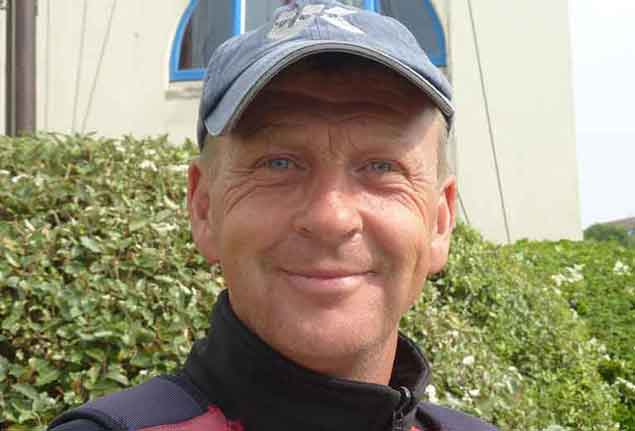 Simon McGibney leads ICRA with energetic enthusiasm
Simon McGibney leads ICRA with energetic enthusiasm
But enough of such dreaming, there was serious business to be done. And with people of the calibre of ICRA Commodore Simon McGibney of Foynes YC and ICRA number-cruncher Denis Kiely of Kinsale as joint MCs, the pace was impressive.
Simon is the leaping-about man, making his points here, there and everywhere, and when he reckons he isn’t everywhere enough, his fellow Foynes yottie and sailing instructor Elaine O’Mahoney dances in to give assistance.
Denis by contrast is Buddha-like. He sits in the one place with a commanding view of everyone, and orchestrates proceedings and Q&A sessions with a natural authority which makes you think he should be right there in Geneva or wherever it is, bringing order and peace to the Middle East.
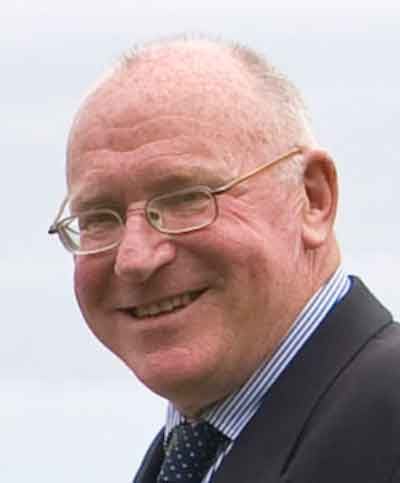 Denis Kiely gave us all an object lesson in how to orchestrate a conference and handle Q&A sessions
Denis Kiely gave us all an object lesson in how to orchestrate a conference and handle Q&A sessions
For people for whom sociable business conferences are a regular part of life, I presume all this is all run-of-the-mill. But I’m the single spy who works alone in a rat’s nest of an office with a clutter of material within arms reach when it’s not available on the proper-size screen which rules my life, so experiencing human interaction at this level is bracing, to say the least.
And the ICRA annual gathering is such a clearcut focal point for a certain type of sailing enthusiast that it attracts international attention. Last year, we had Dobbs Davis and Zoran Grubisa of the Offshore Racing Congress promoting their measurement rule. As one had travelled from America while the other had come from Croatia to spread the message, I suppose the fact that the man from the International Rating Certificate office had only come over from Lymington to talk to ICRA wasn’t such a big deal. But Mike Urwin is such an obliging bloke, and an entertaining speaker with it, that we can’t help but nurture a secret hope that the possible discussions under the aegis of the RORC about amalgamating the two systems go on for ever, for their success might deprive us of entertaining speakers….
 Mike Urwin made the case for IRC in engaging style
Mike Urwin made the case for IRC in engaging style
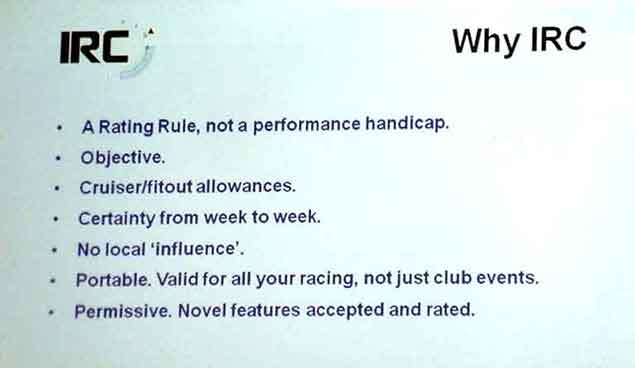 What the IRC does
What the IRC does
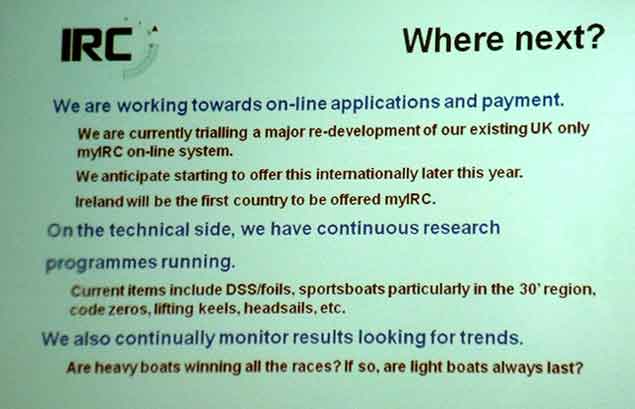 The prospects for IRC. Ireland is going to be the test-bed for the internationalization of the online service.
The prospects for IRC. Ireland is going to be the test-bed for the internationalization of the online service.
I’d an insight into the special role Mike fills in the international offshore racer community one summer’s evening a year or two back, when I’d an email from a guy on quayside in the Mediterranean where he’d found himself looking at the Ron Holland-designed Irish Mist II of 1975 vintage, and that very special boat had a Se Vende notice. She was built in Cork for Archie O’Leary to come out as a distinctly potent machine around 40ft long, and our man on the quay guessed that he might have a worthwhile performer for the Committee International Mediterannee (CIM) vintage IOR class, if only he could be sure that an IOR Rating for Irish Mist II from the 1970s could be given full provenance.
When you get such a message outside of what used to be called working hours, time was when you’d put off dealing with it until the next morning. But I simply fired off an email to Anthony O’Leary whom I knew to be doing Cowes Week in Antix at the time, and from the midst of some après sailing pub came the message: “Mother of God, does this guy think I carry a filing cabinet around with me? And anyway, in the 1970s I’d better things to do than look after the paperwork”.
But then half an hour later from another pub came the message “Rob Jacob says we should signal Mike Urwin, will let you know”. And believe it or not, before the night was out, we had the word that Mike had been able to access an IOR Rating Certificate for 1978 for Irish Mist II, and all was well with the world.
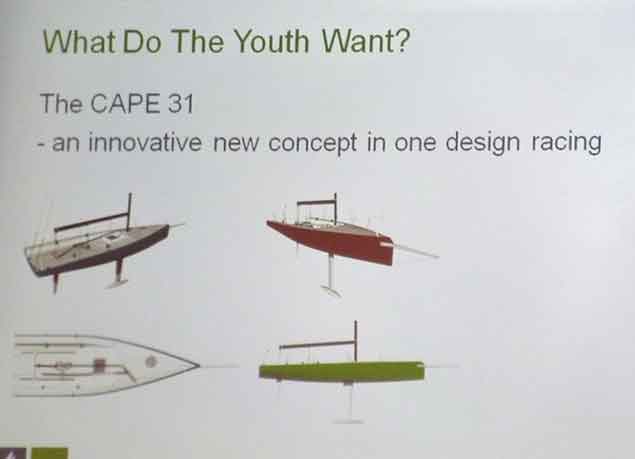 Nobby Reilly is convinced young Irish sailors will be looking to boats like the new Mark Mills-designed Cape 31. Old salts will know the original Cape One Designs of 1956 provided the hull shape for the famous Black Soo.
Nobby Reilly is convinced young Irish sailors will be looking to boats like the new Mark Mills-designed Cape 31. Old salts will know the original Cape One Designs of 1956 provided the hull shape for the famous Black Soo.
As to matters in Limerick, the conference got off to an energetic start with former Commodore Nobby Reilly of Howth analyzing what the new generation seeks in cruiser-racers to guide us into a theme of the day, the ever-present need to make the world aware that cruiser-racing – whether inshore or offshore - can be great sport. And the tinkering with your boat to maximize your rating is not a drawback - on the contrary, it’s part of the technical interest of the sport in its broadest sense. On top of that, there’s funding available from ICRA for clubs which want to develop cruiser-racing as part of their local programme, and there’s a wide range of support material which will raise the ICRA presence in your area and prove mutually beneficial.
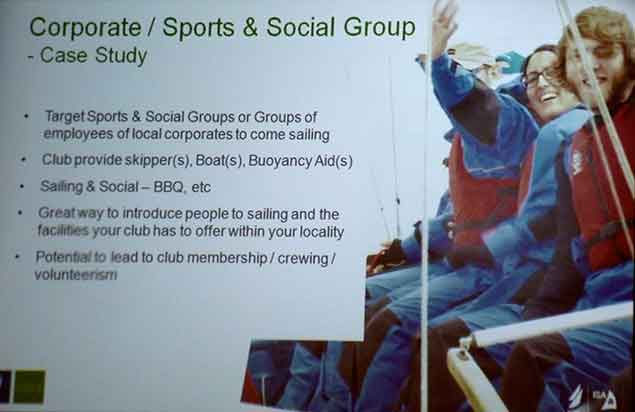 A case study of corporate promotion was presented…..
A case study of corporate promotion was presented…..
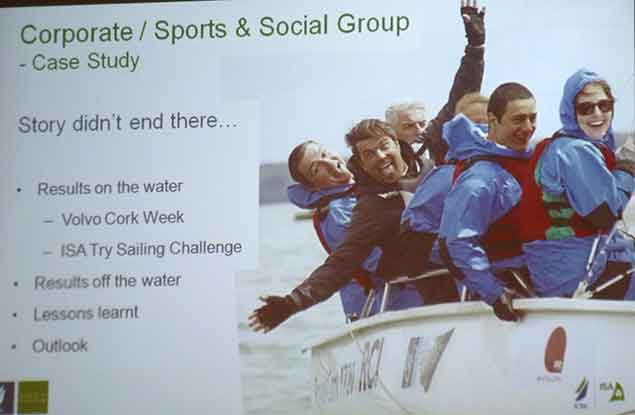 ….and we got the follow-up too
….and we got the follow-up too
Particularly interesting was the presentation from Colin Moorehead with useful interjections from Denis Kiely about how the Training Grant scheme and the promotion with the ISA of the Try Sailing project in the context of Colin’s own club, the Royal Cork, had been so successful that at Afloat's and the ISA's National Sailing Awards at the end of January, Colin was singled out for an award himself.
Simon McGibney then took over for an energetic outline of the working of the Crewpoint scheme, to let people know that the most important thing – as in so many areas of life – is simply to turn up, ICRA and other volunteers will take it from there, and you’ll get your introduction to sailing.
 Simply turn up – the ICRA, ISA and Club volunteers will take it from there
Simply turn up – the ICRA, ISA and Club volunteers will take it from there
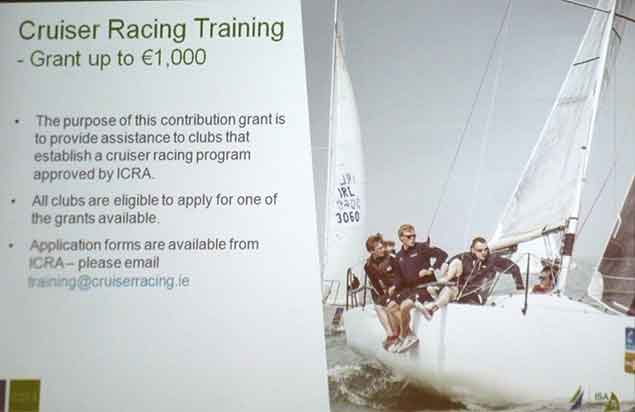 Need we say more?
Need we say more?
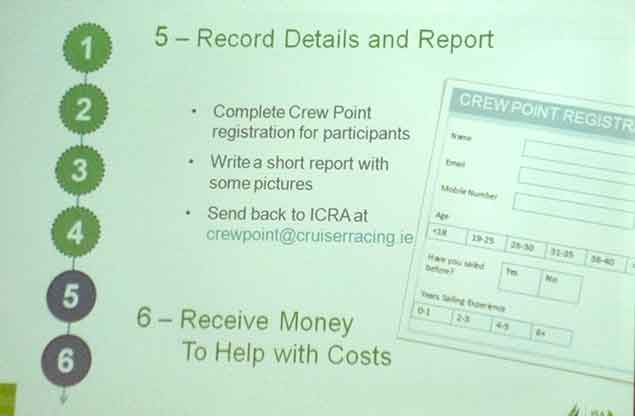 All that ICRA ask is that you clearly display their banner and don’t just leave it in a cupboard, and you report back to them on the progress of the programme
All that ICRA ask is that you clearly display their banner and don’t just leave it in a cupboard, and you report back to them on the progress of the programme
Sensibly refreshed by lunch, we found any tendency to a post-prandial zizz completely blown away by Maurice the Prof O’Connell’s presentation on Embarr’s world championship win. It was riveting stuff, with the effort involved generally – and not just the superhuman dedication to achieving maximum fitness and optimum crew weight – giving a vivid illustration of the utter diversity of our sport, which takes in everything from gentle sailing in a local classic class to the Worlds of specialist boats like the Melges 24.
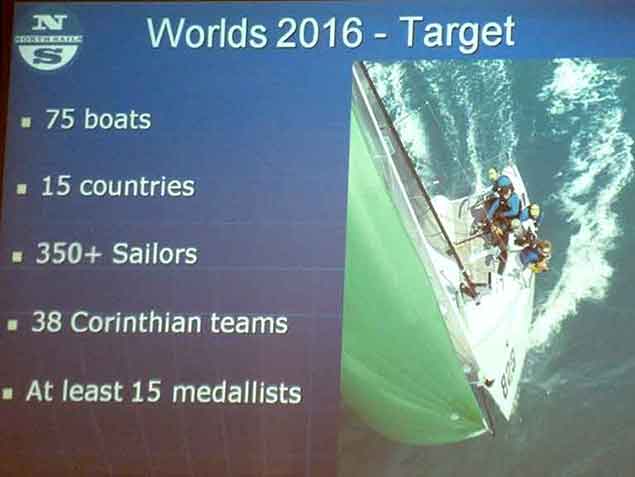 A mountain to climb – the target set for Conor Clarke’s Embarr
A mountain to climb – the target set for Conor Clarke’s Embarr
 The programme to get there…
The programme to get there…
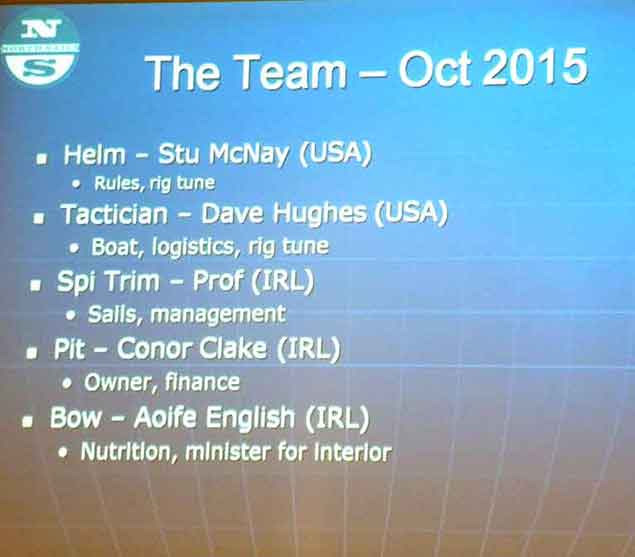 And the team that did it
And the team that did it
It’s easy to complain that the existence of more than 150 recognised World Championships in sailing dilutes the impact of the sport. But the truth is that this diversity is central to the whole picture, and sailing benefits by so many valid prizes being available for the wide range of One Design classes.
And that’s before we moved on to Mike Urwin’s presentation on the added level of diversity which is dealt with through the IRC. Of particular interest in Ireland was his assertion that “protecting the existing fleet” is at the core of the IRC’s functioning, for the fact is many of us are optimising and actively racing boats which would be older than those found elsewhere.
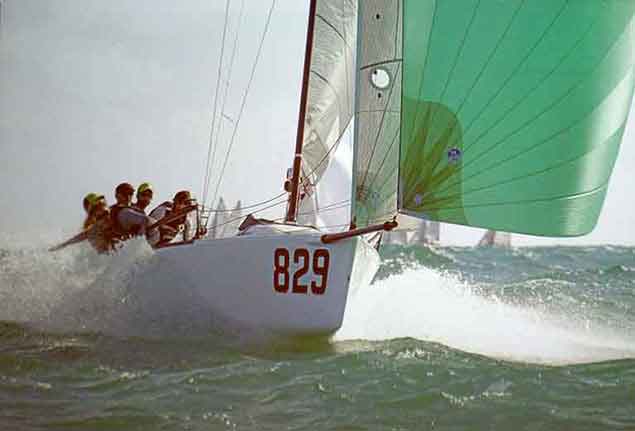 We have a result…..Embarr on her way to winning the Worlds, November 2016
We have a result…..Embarr on her way to winning the Worlds, November 2016
We do so through a crowded programme of events. ICRA tries as far as possible to take the mission to as many clubs as possible, thus it prefers to maintain the independence of its National Championship, rather than subsuming it into some larger regatta. So special attention was paid to Paul Tingle of Royal Cork, as he is organising the ICRA Nats there on from June 9th to 11th. It’s a time when the activity levels are soaring throughout sailing, but the lure of the Nationals carry their own appeal against what might be seen as rival events.
Certainly regular readers of Afloat.ie will be well aware of the energetic levels of discussion as to how the annual sailing programme might be better structured. But if you insist on amalgamating events and championships, you reduce the significance of the prizes involved. Not everyone aims to win a World championship, but it’s encouraging to any crew to finish with their name up in lights just now and again. So in tandem with the continuation of a crowded programme, the development of ICRA’s Progressive ECHO performance handicap system is another important part of this significant organisation’s contribution to Irish sailing.
As ever, the conference ended on the highlight of ICRA “Boat of the Year”. On Afloat.ie in the week from Monday February 27th until the conference itself on Saturday March 4th, we ran an online poll which had a very gratifying response. But as with other awards, it was done in the knowledge that such polls are only advisory, as judges have a job to do to keep populism under control.
Thus in the Afloat.ie poll. Jonny Swann’s Half Tonner Harmony from Howth topped the votes at 949 (39.9%) while John Maybury’s J/109 Joker 2 from the Royal Irish YC in Dun Laoghaire logged 831 votes to come in at 35%. Yet it was Joker 2 which became Boat of the Year 2016, and rightly so, but maybe somebody should have come up with an award for Boat Which Most Stylishly Survived A Port Tack Mark Rounding Event During A Major Championship Trophy for Harmony…
Taking the road home for that night’s awards event at the Royal Irish, the thought processes were at first dominated by ideas put forward by Peter Ryan the chairman of ISORA, and John Hughes who has now taken on the mantle in Wicklow of running the Round Ireland Race, as I’d been sitting with the two of them during the Conference.
Both as ever were bubbling with ideas, but John particularly has one which will be of interest, as on the same day as he starts the next Round Ireland Race in June 2018, he will start a much shorter co-event, from Wicklow to Cork Harbour, with the Royal Cork at Crosshaven hosting the finish.
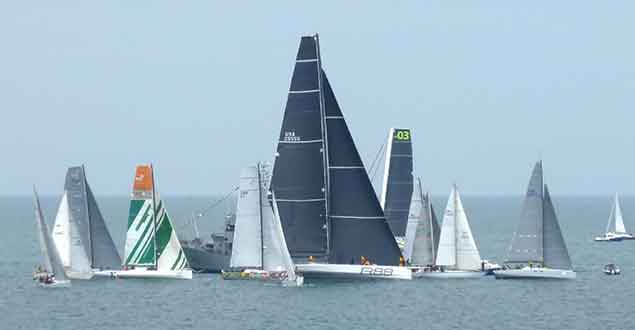 George David’s Rambler 88 finding her way through a motley fleet at the start of the Volvo Round Ireland Race 2016. What would it be like if the start of the classic Round Ireland Race in June 2018 was combined with its proposed new shorter sister, the Wicklow to Cork Race? Photo: W M Nixon
George David’s Rambler 88 finding her way through a motley fleet at the start of the Volvo Round Ireland Race 2016. What would it be like if the start of the classic Round Ireland Race in June 2018 was combined with its proposed new shorter sister, the Wicklow to Cork Race? Photo: W M Nixon
The debate was whether or not he should start the shorter race before or after the main event, but it was somewhere in the midst of zooming through a rainshower in Laois that I realized he should start them together. Boats would be invited to enter both races (at the full entry fee, of course) and then as they’re slugging to windward off Cork Harbour on Sunday night and in the small hours of Monday morning, when some sad and seasick crewman says he or she wishes they were racing to Cork Harbour, the kindly and generous owner-skipper can say: “We are!”, he then throws a right into Cork Harbur, but they still have a result…..
It was all a suitably daft scenario to get oneself in the right frame of mind for dinner through an evening and night in the Royal Irish Yacht Club in Dun Laoghaire, an establishment of which a notably acerbic observer of Irish sailing has remarked: “Irish sailing is divided into those who get the Royal Irish, and those who don’t, and that’s all there is to it”.
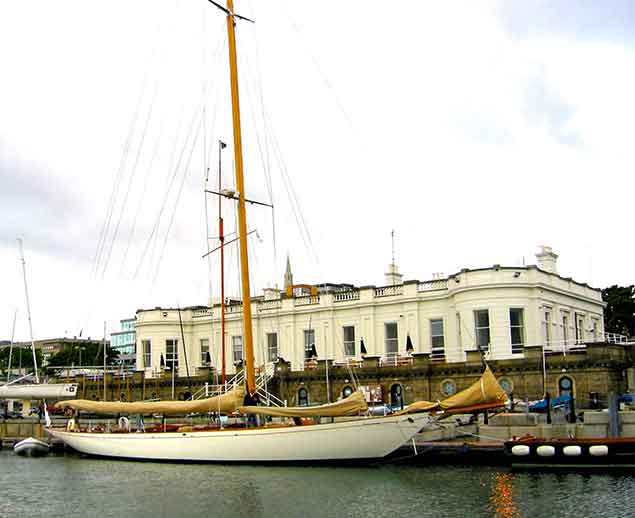 “You either get it, or you don’t…..” The Royal Irish Yacht Club in Dun Laoghaire, with the Fife-desgned 70ft Hallowe’en, line honours winner in the 1926 Fastnet race, berthed alongside. Photo: W M Nixon
“You either get it, or you don’t…..” The Royal Irish Yacht Club in Dun Laoghaire, with the Fife-desgned 70ft Hallowe’en, line honours winner in the 1926 Fastnet race, berthed alongside. Photo: W M Nixon
Definitely a case for Ethnic Minority Status here too, one might think. But anyone who reckons this unique establishment is above the hurly burly of every day competition afloat would already have been put right by being in Limerick, and realizing that both Conor Clarke’s Embarr and John Maybury’s Joker 2 are part of the Royal Irish fleet. Nevetheless I’d received an invitation that could be interpreted ever which way, so the best thing was to hide oneself in a table of very good friends among whom the classic boat ownership included two Water Wags, three Howth Seventeens, and an indeterminate number of Dublin Bay 21s, two of which may have changed hands during the course of the evening.
Next door to us was the much larger and more boisterous assembly of George Sisk’s crew apparently - as since revealed in Afloat.ie - deciding they were by no means past it yet, and working towards supporting their skipper in a decision for a new Class Zero boat. The evening drew on, and then with classic laid-back RIYC style, Rear Commodore (Sailing) Patsy Burke oversaw the awards which saw the following honours:
Boat of the Year: Jim McCann & Paul Cadden (Peridot)
Cruiser of the Year: Des Cummins & Storme Delaney (joint winners)
Best International: Saskia Tidey and Andrea Brewster (49erFX)
Best IRC: Colin Byrne (Bon Exemple)
Best Cruiser-racer ECHO: George Sisk, WOW
Traveller Award: Paul Smith & Pat Mangan (Jill)
Best One Design Result: Ger Dempsey & Chris Nolan (Venue’s World)
Best White Sail Result: David Clarke (Fortitudine)
Contribution to Sailing: Henry Leonard
Most improved boat: Derek Butler (Borraine)
Best Big Boat Performance: Enda O’Coineen (Kilcullen Voyager)
Volunter of the Year (House): Winifred McCourt
Volunteer of Year (Sailing): Tim Carpenter & Kevin Leonard (joint winners)
Most improved Adult Sailors: Katherine Sheehan & Tony Barlow
Somewhere in the midst of it, your reporter received an award for scribbling, And as you’ll note the intrepid Enda O’Coineen was honoured for his astonishing achievements against the odds during 2016 in his Open 60 Kilcullen Voyager, for it was a cruel swipe of fate that his mast should come crashing down on January 1st 2017.
Thus your reporter was left looking like a stunned mullet, as for some reason I’d got it into my head that there was a literary dimension to it all, and the reason I’d been invited was to honour Enda O’Coineen’s best contribution to Irish sailing in 2016. We highlighted it here on Christmas Eve. But it’s well worth looking at again:
National Yacht Club Pair Back in Top Ten At Flying Fifteen Worlds, Jerwoods Sail Into Contention in New Zealand
What a difference a day makes, the sun came out for day four of the 21st Lexus Flying Fifteen World Championship in Napier writes Johnny Fullerton. Race 5 was sailed in a light NE breeze shifting from 40 - 50 degrees, but with a short chop rather than the rolling swell of the last few days. As they say in these parts, the lambs were just about to leap out of the paddock, allowing the bigger crews to get out on the side decks and even do a bit of hiking! Ireland's sole interest represented by National Yacht Club pairing Charles Apthorp and Alan Green are back in the top ten overall after five races sailed.
57 Fifteens were spread across the start line in a far more conventional start but with new choices over upwind tactics. Whilst the majority of the fleet decided to work the left, a late shift favoured the boats that had really banged the right corner hard!
Of these kiwis, Brian & Bridget Kent from Royal Akarana YC in Auckland, sailed a blinder to round the top mark in the lead from the Flying Flamingos, Lewis Davies & John Radnell from Daveys Bay YC in Australia. (These guys are easily recognisable with their pink, hats, kite and accessories!. Another kiwi boat in the Silver fleet, Wade & Lyle Tresadern from Bucklands Beach in Auckland, rounded in 3rd.
Most of the usual suspects were a bit deep in the pile with work to do but It only took the first run to see some of the downwind specialists starting to make their move. Steve Goacher rounded in the top 15 but scythed down the middle of the course to put pressure on the leaders at the gate. Nick & Janet Jerwood (AUS) were also working their way into the mix after a late change of gate choice at the gate got them on the right side of the race course for the beat.
Back upwind the pressure stayed a bit more reliable but a new leader was emerging in David Williamson & Craig Morton (AUS) from Mordialloc SC in Victoria. The Aussie crew had the two previous world champions chasing them down both legs of the triangle. Behind them there was a lot of shuffling in the lead pack, places could be won or lost on the boat handling at the gybe mark. But the real test was the final working leg to the finish. This is where the real champions work their magic and there was little surprise when the smiling faces of Nick & Janet Jerwood from South of Perth YC, were seen tacking up to the line with a reasonable lead. They crossed to take their first gun of the championship and leap back into contention for the tile with two days to go.
“We had two very difficult legs, we got to the top mark in the low teens and managed to get the bottom of the run wrong and lost a lot of spots there, I am guessing we were about 20th there. Things stated to get a bit better from there, we made a late decision to change gates at the bottom and it was a really good decision, put us on the right side of the course and we were able to pick a few good shifts which put us back into the top 10 and we took a few more as we progressed up to the beat to 4th so that was the best leg of the regatta for us so far from 20th to 4th.”
“Two days to go but we still have to sail the best race you can, the wind is way too localised, you can be 4 or 5 boat lengths away from somebody and be in totally different conditions so you just have to sail the best you can with what you have at that point in time. It is just going to be a case of how fast you can get round that race course. We actually used toe straps for the first time in the regatta today and it was great so I am looking forward to more of that in the final two days.” Nick Jerwood
Second to finish was Steve Goacher & Tim Harper (GBR) who is now able to drop his 19th place to take the overall lead in the regatta by 4 points. With the discard coming into play, the overall leaderboard sees a few changes with previous leaders Matthew Owen & Andrew Reed (AUS) from Canberra, slipping to 3rd overall, and Ashley Smith & Adam Kingston from Queensland (sailing under the Hong Kong flag), dropping their 35th to jump up to 4th in the overall classification.
With two days to go the pressure is rising and so is the barometer. There is a promise of more warm weather and a bit more breeze which might just suit some of the bigger crews who enjoy a bit of planing activity for which the Flying Fifteen is famous for.
Race 6 is scheduled for a 1300hrs (local) start time.
Results (Top 10 of 57 entries, after 5 races with 1 discard)
1 GBR 4021 Steve Goacher / Tim Harper - (19),8,1,1,2 = 12pts
2 AUS 3986 Nick Jerwood / Janet Jerwood - 5,2,8,(20),1 = 16pts
3 AUS 3684 Matthew Owen / Andrew Reed - 2,4,7,9,(12) = 22pts
4 HKG 3972 Ashley Smith / Adam Kingston - (35), 46,4 = 28pts
5 GBR 4005 David McKee / Mal Hartland - 7,10,2,10,(23) = 29pts
6 GBR 3760 Jeremy Davy / Martin Huett - 9,5,10,7,(16) = 31pts
7 NZL 3840 Murray Gilbert / Jonathan Burgess - (32), 9,6,13,5 = 33pts
8 NZL 3091 Hayden Percy / Scott Pedersen - 1,6,22,5,(25) = 34pts
9 GBR 4004 Charles Apthorp / Alan Green - 6,(53),14,2,15 = 37pts
10 AUS 3859 David Yu / Chris Nelson - 3,1,9,26,27 = 39pts
Another semi-overcast afternoon in Napier for the second day of the Lexus Flying Fifteen World Championship in Napier, New Zealand. Just one race was held in light Easterly breezes between 5–8 knots. National Yacht Club pair Charles Apthorp and Alan Green are 26th overall after three races sailed. Download the results below.
After one general recall the PRO Gerry Martin, started race 3 of the champi-onship under the U flag with all 57 competitors spread across the length of the start line. The first upwind leg was well spread but sailors who got off the line cleanly and into clear air, were keen to get to the middle right of the course, to take advantage of the breeze flicking right in Hawkes Bay.
At the top mark, David Mckee & Mal Hartland (GBR) from Dovestone SC, led closely followed by class stalwart Steve Goacher & Tim Harper from Royal Windermere/Southport SC. Local sailors David Zorn & Graeme Robinson from Napier SC, sailed an excellent first work to round in 3rd. Also in the mix were two boats from Western Australia, Philippa Packer, crewed by former world champion, Dean McAullay from Royal Freshwater Bay YC and champi-onship leader David Yu & Chris Nelson, also from (RFBYC).
The lead three broke clear to head down the run back to the gate as the breeze softened even more. Slowly the (3 time) former world champion, Ste-ve Goacher soaked down inside McKee & Hartland, to round a boat length in the lead at the gate. Kiwis Zorn & Robinson floated round in 3rd as places changed behind them when the fleet converged under collapsing spinnakers.
The second work became a bit of a soldiers course, although picking the way through the shifts and keeping the boat moving in the light airs required a lot of concentration.
The order was the same at the top mark second time around but on the trian-gle leg via the wing mark the two lead British boats extended in their own pri-vate battle, whilst Zorn & Robinson had to work really hard to hold their third place. Other places in the top ten became much more intense as the breeze dropped below 5 knots. New Zealanders, Murray Gilbert & Jonathan Burgess from Royal Akarana YC in Auckland and the Queenslanders, Ashley Smith & Adam Kingston representing Hong Kong, made good gains.
Rounding the bottom gate, the leaders had an agonising 1nm leg back to the finish line. Goacher & Harper extended for a bit more breathing space, cross-ing the line to win their first race of the 21st Flying Fifteen Worlds. Mckee & Hartland settled for 2nd but the biggest celebration waited for 3rd place as lo-cals Zorn & Robinson punched the air taking an excellent 3rd.
“We got a good clean fast start and sailed a short distance to clear the guys to weather of us and flicked on to port and hit the right hand side and were sitting pretty nicely.”
“It was really tense on the last lap especially with Murray and Johno, they are fast downwind, they were right on our tail at the bottom mark last time. But we knew where we wanted to go and knew the line we wanted to take and just stuck with it.”
David Zorn.
Smith & Kingston (HKG) had a much better day crossing in 4th and Rob Ward & Bruce Yovich (NZL) from Onerahi YC a very respectable 5th. Overall scores after 3 races leaves David Yu & Chris Nelson (AUS) and Matthew Owen & Andrew Reed tied on 13pts with the ever consistent West Australian former world champions, Nick & Janet Jerwood (SoPYC) in 3rd.
Steve Goacher explains his race;
“We had not such a bad start and a good clean first beat, we rounded the windward mark in second and managed to pass the leader downwind on the first run. I don’t mind the light conditions, they are enjoyable when you are in the front! I grew up sailing on Lake Windermere and we get a lot of light and fluky sailing conditions there.”
And on sailing in Napier for the first time;
“I have been sailing 15’s since 1991 and won three world championships on the trot, 1995, 1997 & 1999 but I have never sailed in Napier. It has been very testing conditions, last week we had quite big seas and not a massive amount of wind.”
Race 4 of the championship is scheduled for a start time of 1300hrs (local time) with a similar forecast of light winds.
Provisional Results (Top 10 of 57 entries, after 3 races)
1 AUS 3859 David Yu / Chris Nelson - 3,1,9 = 13pts
2 AUS 3684 Matthew Owen / Andrew Reed - 2,4,7 = 13pts
3 AUS 3986 Nick Jerwood / Janet Jerwood - 5,2,8 - 15pts
4 GBR 4005 David McKee / Mal Hartland - 7,10,2 = 19pts
5 GBR 3760 Jeremy Davy / Martin Huett - 9,5,10 = 24pts
6 GBR 4021 Steve Goacher / Tim Harper - 19,8,1 = 28pts
7 NZL 3091 Hayden Percy / Scott Pedersen - 1,6,22 = 29pts
8 GBR 4030 Greg Wells / Richard Rigg - 4,14,15 = 33pts
9 NZL 3739 Aaron Goodmanson / Alister Rowlands - 18,3,13 = 34pts
10 NZL 3542 Rob Ward / Bruce Yovich - 11,29,5 = 45pts
Beneteau 34.7 Black Velvet Takes Early Lead In DBSC Spring Chicken Sailing Series
A great turn–out after two cancellations got the 2017 DBSC Spring Chicken Series for Sailing Cruisers off to a great start on a lovely day at the National Yacht Club last Sunday.
The Beneteau 34.7 Black Velvet was the first race winner and leads two 1720 sportboats; Wolfe and Optique.
Full results are downloadable for the Rathfarnham Ford sponsored series are below.
Annual Mermaid Prizegiving Dinner Continues to Grow
This year marked the third consecutive year that the Mermaid Sailing Association held a stand-alone Prizegiving Dinner event to properly acknowledge the winners of the sailing season just gone. Now normally held around February time, this event gives a fantastic opportunity for the class to close out the sailing season just gone and look forward to the one shortly coming up. On the evening of the 18th of February, with the club fully decked out and over 80 people sitting down for a fantastic three course meal provided by the team at Skerries Sailing Club, this year’s Prizegiving dinner followed the success of the 2 years previous and the night was thoroughly enjoyed by all.
Kieran Branagan, Commodore of Skerries Sailing Club gave some nice opening words expressing how excited the club is to host this year’s Mermaid National Championship on what is the 85th Anniversary for the class. With at least 2 races per day planned over a full 6 days racing (7 if you count the practice race), this year’s National event is promising to give a fantastic week full of top class racing and entertainment making for the perfect week’s holidays for true sailing nuts!
Brian Mc Nally of Skerries Sailing Club also gave a fantastic opening speech as part of his newly appointed position as the Mermaid Class Captain for Skerries. He recalled back to one of his first ever Mermaid Championships where he was eager to please the skipper and let’s just say there were a few learning curves! The Mermaid fleet are known just as well for their excellent social scene and comradery as they are for their racing and Brian’s story was testament to this fact as he recalled how this event was also where he first laid eyes on his now wife, Valerie! The speech got the room into a really positive and “humorous” mood which followed through for the rest of the awards, making for some very interesting speeches. It’s clear from the smiles on everyone’s faces in the pictures just how much fun everyone actually had on the night.
A summary of the prizes awarded on the night are as follows:
The Skipper Clarke Memorial trophy which is awarded to the winners of the National Yacht Club Regatta or combined clubs Dun Laoghaire Regatta was presented belatedly to 134 Jill for 2014 and 2015. There was no race in 2016.
The Skipper Clarke Memorial trophy being awarded by MSA President Des Deane to 134 Jill, Paul Smith, Anne Smith and Pat Mangan from the Royal Irish Yacht Club, Dun Laoghaire.
The Mermaid National Championship cups were awarded as follows:
• The Rockabill Cup, Championship Race 1, 189 Azeezy
• The Dorene Models Cup, Championship Race 2, 77 Tiller Girl
• The North Bull Cup, Championship Race 3, 189 Azeezy (Not presented as this cup’s whereabouts are unknown)
• The Mavis Cup, Championship Race 4, 77 Tiller Girl
• The Rush (Carthy) Cup, Championship Race 5, 189 Azeezy
• The Bailey Cup, Championship Race 6, 123 Vee
The Designer’s Tankard which goes to the best championship boat where the top 2/3 of boats from the previous Championship are excluded went to 182 Dolphin helmed by Shay O’Toole with his crew Seamus Murray and Pierce Benyon.
The Designer won by 182 Dolphin, Shay O’Toole
The Daphne Cup which goes to the best championship boat where the top 1/3 of boats from the previous championship are excluded was won by 186 Gentoo helmed by Brian McNally with crew Valerie McNally and Keith Rochford.
The Daphne won by 186 Gentoo, Brian McNally
Along with the main class trophies and cups, the official ISA medals (which were all beautifully engraved and customized) were also awarded for 1st, 2nd and 3rd place overall. Bronze Medals went to Jonathan O’Rourke, Carol O’Rourke and Tom Murphy from 77 Tiller Girl who finished 3rd overall in the 2016 Mermaid National Championship held at Howth Yacht Club.
Bronze ISA medals awarded to Jonathan O’Rourke, 77 Tiller Girl
Silver went to 131 Wild Wind helmed by Paddy Dillon and crew Johnny Dillon and Mo Dillon for finishing 2nd place overall at the 2016 National Championship, a fantastic result for the Dillons having won the National Championship the year previous in 2015.
Silver medals won by 131 Wild Wind
And the number one spot for overall National Champions 2016 went to 189 Azeezy helmed by Sam Shiels with crew Con Bissett and Eoin Boylan. Needless to say they are truly delighted with their Gold ISA medals and the beautiful Mermaid trophy and were the stars of the night taking the top prize in their home club.
Gold ISA medals awarded to overall 2016 National Champions 189 Azeezy
The growing, continued success of the event is proof of the great positive work that is being done in the class with some new boats and members joining and Skerries campaigning to get 35 boats at the Nationals this year. It’s fantastic to see all the hard work and volunteerism starting to pay off. Everyone is now looking forward to the Mermaid season ahead which kicks off with club racing in May and the first official Championship event being held at Foynes Yacht Club on the 3rd and 4th of June for the Munsters.
The MSA would like to thank everyone who came along and supported the night making it so enjoyable. MSA President Des Deane and Hon Secretary Paul Smith did a great job hosting the awards and handing out the prizes. Thanks also to Ross Galbraith for providing the photos and of course to Skerries Sailing Club for putting on such an enjoyable event.
New members are always welcome to the Dublin Bay Mermaid class If you would like to inquire about getting involved or even coming out for a sail on one of these beautiful classic boats, please don’t hesitate to get in touch with Secretary Paul Smith on [email protected].
London 2012 Olympic Games Race Officer Jack Roy, who is DBSC Principal Race Officer and ISA Director of Racing, is organising an ISA Race Officer Level 1 Course which will be run over two evenings – Tuesday March 28th and Tuesday April 4th in the National Yacht Club from 7pm to 10pm.
The course is a basic introductory course and is the first step on the road to becoming a Local Race Officer with the ISA. Each course participant will receive a certificate and this is the first step on the ISA Race Officers Pathway programme. Having successfully completed the course participants will be permitted to use the ISA Passport system which is an online logbook that records progress through the 5 disciplines of race management.
Jack will include some material specific to DBSC race management procedures and requirements. We would like to encourage anybody interested in race management to attend the course. For those who already have some experience it is an opportunity to complete the first step of the Race Officer Pathway programme.
The cost of the course is €20. You can register and pay online via the following link on the ISA website here
If you require any further information please contact Sarah-Louise Rossiter, ISA, email [email protected], or Ann Kirwan, DBSC, email [email protected]
National Yacht Club Flying Fifteen Duo head For South Pacific World Championships
Alan Green and Charles Apthorp of the National Yacht Club head for the Flying Fifteen World Championships in New Zealand on Thursday - Summer racing in the South Pacific. Alan and Charles team up for many events and Charles whose regular sailing is from Hayling Island is an overseas member of the NYC and frequent visitor to Dublin Bay.
The proven pair have previously placed second overall at a World Championships.
The world championships will take place on the North Island hosted by Napier Sailing Club, some of whose fleet competed in the worlds in 2003 hosted in Dun Laoghaire.
Napier is a coastal town situated about mid point on New Zealand’s North Island East Coast. Set amid the renowned wine-producing region of Hawke’s Bay and rebuilt after an earthquake in 1931. Napier is known as the Art Deco capital with period architecture.
A tree lined waterfront promenade with statue of “Pania of the Reef” the Maori maiden symbol of the town (New Zealand’s Granuaile) and fronts onto a natural bay with no commercial traffic so a great championship racing venue, a bit like a bigger Killiney Bay without the mountains.
Napier Sailing Club founded in 1891 has a large dry sailing area outside fronting onto a municipal marina and fishing quay. The Flying Fifteen racing is well established at Napier and illustrated on a mural of Flying Fifteens racing on a wall on the seafront.
With 59 flying fifteens entered there will be a strong representation from their Australian neighbours.
Yacht Race Judges Sit For Dinner At The National Yacht Club
The Dublin Judges Group is an informal grouping of ISA Judges (and would-be judges) in the Greater Dublin area.
The group provides a useful service for clubs, classes by transmitting their requests for judges to man protest committees for events.
The social highlight of the group's year is our annual dinner. The dinner will be held in NYC tomorrow (Friday, 3rd February).
All judges, or indeed anyone who enjoys a discussion of the more arcane points of the rules, is welcome. It is not too late to book your place at this prestigious, and sometimes raucous, gathering.
Please contact the group at [email protected]
National Yacht Club Seeks Nominations for Club's 2016 Sailing Awards
The National Yacht Club is seeking nominations from members for its 2016 sailing awards. A leading Dun Laoghaire club, it is also the home club of Olympic silver medallist Annalise Murphy, so there can be little doubt about the award of The John Byrne Memorial Trophy, the prize for the member who achieves the greatest contribution to sailing in NYC during the year.
The club's award system, however, also honours a wide range of other sailing achievements with ancient trophies to honour endeavour in family cruising, youth sailing and race management.
The NYC club trophies are as follows:
Township
The Township Cup is awarded to the member who achieves the best Cruise of the year.
Muglins
The Muglins Cup is awarded for the most interesting family cruise of the year
The Boyne Regatta Cup
The Boyne Regatta Cup is awarded to the members who achieve the best performance in offshore racing of the year.
The O'Leary Cup
The O’Leary Cup is awarded to the member who achieves the best performance of the year in one designs
The Edward Yacht Club Trophy
The Edward Yacht Club Trophy is awarded to the member who achieves the best performance of the year in dinghies, Mermaids or Flying Fifteens
John Byrne Memorial Trophy
The John Byrne Memorial Trophy is awarded to the member who achieves the greatest contribution to sailing in the NYC during the year
The Winkelmann Trophy
The Winkelmann Trophy is awarded to the Cadet member who has had the finest sailing achievement of the year
The Greystones 1892 Regatta Cup
The Greystones 1892 Regatta Cup is awarded to the member who best represented the Club at a team event during the year
Paul Murphy Cup
The Paul Murphy Cup to be awarded to the Club’s Race Management Volunteer who contributed most to race and event management at the Club.
Dun Laoghaire Regatta Casts Net To Celebrate Kingstown Bicentenary
There could well be as many opinions as to what constitutes a true classic or traditional boat as there are owners of these often highly individual craft. As part of the celebration of the Bicentenary of Dun Laoghaire Harbour – where the first stone was officially laid by the Viceroy on 31st May 1817 - the organisers of the Volvo Dun Laoghaire Regatta 2017 (it’s from July 6th to 9th) will be including a Classics, Traditional and Old Gaffer section. This will, in addition to putting extra emphasis on older classes already regularly involved such as the Glens, the Mermaids, the Howth 17s, the IDRA 14s and the Water Wags, be extending a welcome to older boats of other types, and to classic classes from Ireland and around the Irish Sea. W M Nixon reports on progress in this special feature of a very attractive new dimension to Ireland’s biggest sailing event.
If you want anything done in introducing a new twist to sailing, make Cathy MacAleavey the organiser of the special sub-committee in charge of moving things along. And if you want to be sure things are going in the right direction as regards classics and traditional craft, make sure that that Hal Sisk is being consulted and will be personally involved in one or maybe all of his classic craft, for the contribution he has made to the appreciation of our boat heritage in Ireland is unmatched.
Former Olympic sailor and round Ireland record holder Cathy is now herself very much a mover and shaker in the classics, as she has built a Water Wag and a Shannon One Design working alongside the great Jimmy Furey of Leecarrow in Roscommon, and races regularly in both classes.
On being appointed to this completely new post last Autumn by top honcho Tim Goodbody, Chair of the overall Organising Committee, one of the first things she remembered was that while taking part in the Glandore Classics some years ago, she’d been much taken with the Fife One Designs from the Menai Straits, little gems some 24ft 6ins LOA whose design origins go back to 1926, and have been thriving as a class since the 1930s.
 The Royal Anglesey Fifes racing in the Menai Straits. Although the class was first designed in 1926, and gained full strength early in the 1930s, this will be their first visit to Dun Laoghaire. Photo: Ian bradley
The Royal Anglesey Fifes racing in the Menai Straits. Although the class was first designed in 1926, and gained full strength early in the 1930s, this will be their first visit to Dun Laoghaire. Photo: Ian bradley
These days they hunt as a pack and many of them are well organised for road trailing, so on the assumption that they would be heading to the Glandore Classics 2017 on July 23rd, she sent an email to class chairman Richard Tudor suggesting that they might like to take in Dun Laoghaire on the way. It turns out that they won’t be at Glandore in late July as they’re expected to take part in the four yearly Celtic Festival in the Menai Straits at much the same time. But their diary was reasonably clear for the 6th to 9th of July and the Dun Laoghaire festivities, and they’re coming to race for the new Kingstown Cup big time.
This is doubly interesting, for they’re very much a William Fife design and only six inches shorter than the Alfred Mylne-designed Glens, yet the two comparable classes have never raced in the same event. Needless to say the chances of an inter-fleet race in Dun Laoghaire is now high on the agenda.
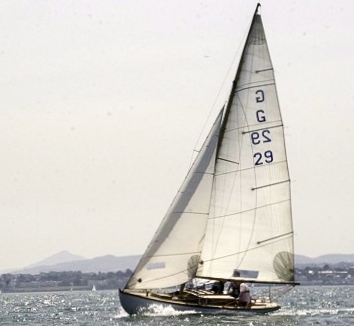 An Alfred Mylne-designed Glen Class OD on her home waters of Dublin Bay in the kind of conditions everyone hopes for in July 2017.
An Alfred Mylne-designed Glen Class OD on her home waters of Dublin Bay in the kind of conditions everyone hopes for in July 2017.
 The Glen class neatly demonstrate their need for traditional moorings in their allocated area off the Royal St George YC
The Glen class neatly demonstrate their need for traditional moorings in their allocated area off the Royal St George YC
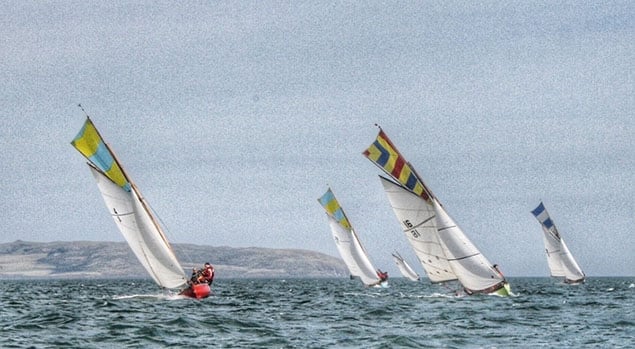 The 1898 Howth 17s will be coming in force from Howth, but they’ve adapted the programme to suit their needs, with a race from Howth to Dun Laoghaire on the Friday, a full day’s racing on the Saturday, a morning race on the Sunday, and then a race home after the prize-giving ceremony.
The 1898 Howth 17s will be coming in force from Howth, but they’ve adapted the programme to suit their needs, with a race from Howth to Dun Laoghaire on the Friday, a full day’s racing on the Saturday, a morning race on the Sunday, and then a race home after the prize-giving ceremony.
So at a stroke, Cathy had given wings to the new event. But at the same time she was casting a fly over Hal Sisk, against whom she regularly races in the Water Wags, but who had his 1894 Watson-designed, Hilditch-built 36ft classic gaff cutter Peggy Bawn on the market, as more than ten years have elapsed since his team completed the wellnigh perfect restoration of this boat in 2005.
Peggy Bawn had been based in Dun Laoghaire Harbour continuously since 1919, and then after her restoration, she became a much-admired feature in classic regattas on both sides of the Atlantic. To say that Hal Sisk has done his duty by her is under-stating the case, yet when Cathy approached him about making Peggy Bawn the centrepiece of the VDLR Classics Regatta, he said he’d already decided to do so, and was looking forward to it very much.
 Peggy Bawn in her newly-restored form in 2005. Anyone contemplating a similar project should spend hours studying this image……Photo W M Nixon
Peggy Bawn in her newly-restored form in 2005. Anyone contemplating a similar project should spend hours studying this image……Photo W M Nixon
While all this was going on in the background, one of the members of Cathy’s sub-committee, Guy Kilroy, was constructing a database of all the classic and traditional classes within Ireland or within reasonable reach. Although most of them are very location-specific and few have the trailers for a long road journey, you just never know who might be swept up in the general enthusiasm for an event which is really beginning to buzz, and certainly the exotic Shannon One Designs will be turning up in strength.
Meanwhile, there’s the mysterious territory which is the Old Gaffer’s Association, which came into being in 1963 when people realised there wasn’t any organisation looking after the needs of boats which weren’t really classics in the strictest sense, yet fitted into so many other categories that they almost defied definition.
Ironically, the OGA was founded in the very year that Dublin Bay’s perfect exemplars of the gaff-rigged racing cutter, the Dublin Bay 21s, changed over to Bermudan rig. Yet as the 2013 Golden Jubilee Round Britain and Ireland cruise of the OGA showed, the Old Gaffers thrive as never before. And as it happened, in 2015 and 2016 the President of the overall Old Gaffers Association was Dun Laoghaire’s own Sean Walsh, owner-skipper of the very gaff-rigged Heard 28 Tir na nOg.
But Sean was due to stand down as President in London in January 14th 2017 – last weekend, in other words. Fortunately, there was just time to convene a meeting of key people before that happened, and a gathering in the NYC of Sean Walsh, Dublin Bay OGA President Denis Aylmer, Ian Malcolm of the Howth Seventeen and Water Wag classes, and Cathy MacAleavey and her husband Con Murphy, did a lot to improve mutual understanding and clarify the in-port needs of Old Gaffers, which are different from those of Classics, which are in turn very different from those of easily-manoeuvred modern craft with auxiliary engines.
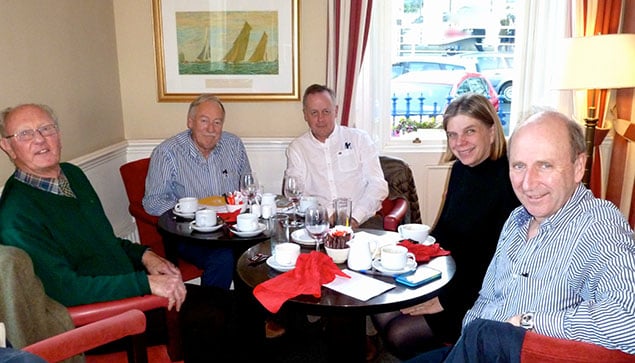
Even before Sean and his team had left for London for the OGA changeover, the word had come through from Paul Keogh, skipper of the Clondalkin community-owned-and-built full-size Galway Hooker Naomh Cronan, that he and his crew would be delighted to take part in Dun Laoghaire in July.
This was another key decision, for the Naomh Cronan is now the only full-sized traditional Galway type on the Irish Sea. But while the great hooker voyager Paddy Barry now sails the seas in a 45ft Frers-designed cutter, it was also confirmed that he too would be taking part, as crew aboard Sean Walsh’s Tir n nOg.
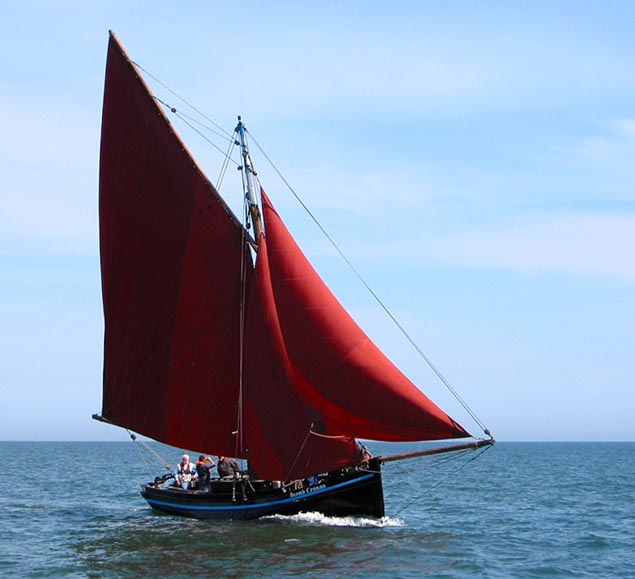 The Clondalkin community-built Galway Hooker Naomh Cronan. Her commitment to the Dun Laoghaire Traditional regatta has greatly encouraged the organisers. Photo: W M Nixon
The Clondalkin community-built Galway Hooker Naomh Cronan. Her commitment to the Dun Laoghaire Traditional regatta has greatly encouraged the organisers. Photo: W M Nixon
 Sean Walsh’s Heard 28 Tir n nOg in racing mode. In Dun Laoghaire in July 2017, his crew will include legendary Galway hooker voyager Paddy Barry. Photo: Dave Owens
Sean Walsh’s Heard 28 Tir n nOg in racing mode. In Dun Laoghaire in July 2017, his crew will include legendary Galway hooker voyager Paddy Barry. Photo: Dave Owens
So the main building blocks of a great event are now going into place, and it’s a matter of building on this sound foundation. With the organisers fully aware of the need to provide proper liaison officers for each special group or class, the need for designated berthing between the Carlisle Pier and the East Pier is also being addressed, as it is the most suitable space, and has the bonus of providing the best possible public view of some of the most interesting-looking boats around.
Thus invitations are on their way to the likes of Scott and Ruth Metcalfe with their characterful schooner Vilma on the Menai Straits, and Mike Clark with his traditional Manx nobby White Heather at Peel in the Isle of Man.
 The Menai Straits-based schooner Vilma (Scott & Ruth Metcalf) is exactly the kind of vessel the Dun Laoghaire event is aimed at. Photo: W M Nixon
The Menai Straits-based schooner Vilma (Scott & Ruth Metcalf) is exactly the kind of vessel the Dun Laoghaire event is aimed at. Photo: W M Nixon
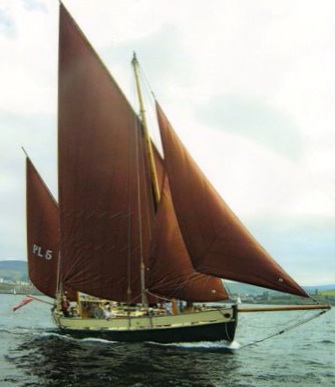 Mike Clark’s Manx Nobby White Heather
Mike Clark’s Manx Nobby White Heather
At the other end of the Isle of Man is Joe Pennington with his restored Manx longliner Master Frank, an asset to any regatta, while across in Strangford Lough Dickie Gomes may have his 1912-built 36ft Kearney yawl Ainmara on the market after 51 years of ownership, but if she doesn’t move he says he is on for Dun Laoghaire.
For several years. Ainmara was Dun Laoghaire-based, but the Dun Laoghaire class which everyone would most particularly welcome back would be the Dublin Bay 24s which raced in the bay from 1947 to 2004. Here’s a rough-cut vid from their final race in the bay in 2004, since then they’ve been taken to Brittany in hope of restoration, but only one has had the complete job done. Originally called Periwinkle, she is now re-named Grace, and is based at Douarnenez, but if she could be persuaded back to Dublin Bay for July 2017, who knows what doors might be opened.
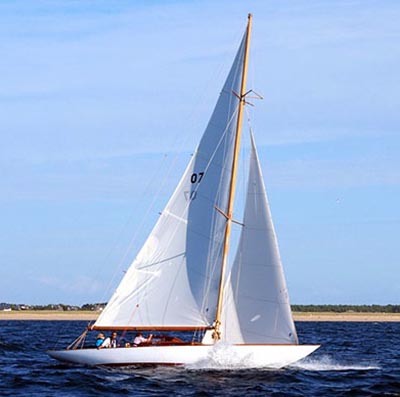 The restored Dublin Bay 24 Grace (ex-Periwinkle) is now reported to be based in Douarnenenz, but she would be very welcome back in Dublin Bay
The restored Dublin Bay 24 Grace (ex-Periwinkle) is now reported to be based in Douarnenenz, but she would be very welcome back in Dublin Bay
Boats of a very different kind came centre stage many years ago in another Hal Sisk initiative, the Bantry Boats built to the design of the ship’s longboat left behind in Bantry after the unsuccessful French invasion of 1796. From the new involvement came the Atlantic Challenge, and you’ll find Bantry Boats at many ports, though there are few enough of them in Ireland. But the Dun Laoghaire festivities would provide an ideal opportunity for them, as the final day of the regatta, Sunday 9th July, is also being pencilled in for a full-on traditional rowing competition for the East Coast Skiffs.
 The Pembrokeshire Bantry Boat sailing off the coast of southwest Wales. Some racing for these very special craft is another proposal for the Dun Laoghaire regatta
The Pembrokeshire Bantry Boat sailing off the coast of southwest Wales. Some racing for these very special craft is another proposal for the Dun Laoghaire regatta
In fact, with so much effort being made to provide proper waterfront facilities in Dun Laoghaire, it’s a case of the more the merrier, and another interesting vessel whose management have indicated positive interest is the Conor O’Brien ketch Ilen, currently nearing completion of her restoration through the Ilen Boat Building School of Limerick at Liam Hegarty’s boatyard at Oldcourt near Baltimore.
Ilen is due to be launched in April and will be in full commission by July. The very fact of having a complete suit of new sails will make her look better than she ever has since she was built in 1927, and if she does turn up to Dun Laoghaire welcome, it will be a very different boat from the tired-looking vessel at the end of her working days in the Falkands, the vessel which was finally, thanks to Gary MacMahon’s initiative, returned to Ireland in 1998.
In other words, so many ideas are flying around about the fresh shapes and new vitality that the Kingstown Bicentenary can add to the Volvo Dun Laoghaire Regatta that all things are possible.
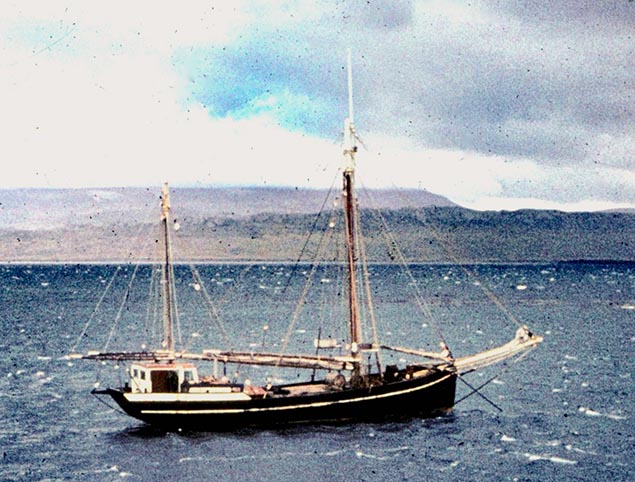 The Conor O’Brien ketch Ilen towards the end of her working days in the Falkland Islands. In fully restored form, she is expected to launch in April of this year, and may well include the Volvo Dun Laoghaire Regatta in her 2017 programme. Photo courtesy Ilen Boatbuilding School
The Conor O’Brien ketch Ilen towards the end of her working days in the Falkland Islands. In fully restored form, she is expected to launch in April of this year, and may well include the Volvo Dun Laoghaire Regatta in her 2017 programme. Photo courtesy Ilen Boatbuilding School



























